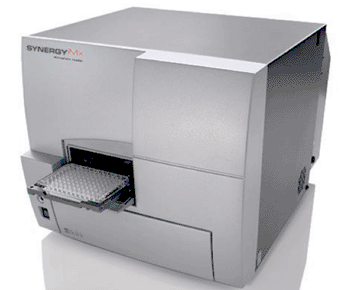Rapid Colorimetric Assay Quantifies Urease Activity
By LabMedica International staff writers
Posted on 13 Nov 2013
A novel high throughput colorimetric urease activity assay was compared to the Nessler method and the new method employs phenol red to determine the urease activity.Posted on 13 Nov 2013
This method is rapid, sensitive, easy, cost-effective, does not use any toxic chemical reagents, significantly reduces sample-processing time, and allows real-time investigations.

Image: Synergy MX Monochromator-Based Multi-Mode Microplate Reader (Photo courtesy of BioTek).
Scientists at the University of Houston (TX, USA) determine the urease activity of seven urease-positive (+) and two urease-negative (−) bacteria from diverse environmental sources. All cultures were incubated for 24 hours at 150 rpm (INNOVA 44, New Brunswick Scientific Co.; Enfield, CT, USA) in their specific growth conditions. The bacterial cells were then adjusted to an optical density of 0.5 at 600 nm with a plate reader.
Suspensions for all microorganisms were inoculated into Stuart's broth in triplicates into flat-bottom 96-well plate and read at 430 nm and 560 nm every 30 minutes for 24 hours with the Synergy MX Microtiter plate reader (BioTek; Winooski, VT, USA). To quantify the urease activity with this new method, the reaction rates were calculated from the absorbance data and they were correlated with the urease activity based on the standard curve of the urease enzyme. The results of this method were compared to the standard Nessler method.
The two methods showed related but not identical values. The Nessler method requires sample collection and preparation steps before measurement of the enzyme activity, but the new method does not, which could explain the slightly different results. In addition, it was found that filtration affects the enzymatic activity, which might be another possible cause for the observed variation between the two results.
The authors concluded that the new method is high throughput, it has decreased analysis processing, and provides a shorter assay work-up. These features make this method a good alternative to the Nessler method for rapid quantification and screening of urease activity. The study was published on October 5, 2103, in the Journal of Microbiological Methods.
Related Links:
University of Houston
New Brunswick Scientific Co.
BioTek













